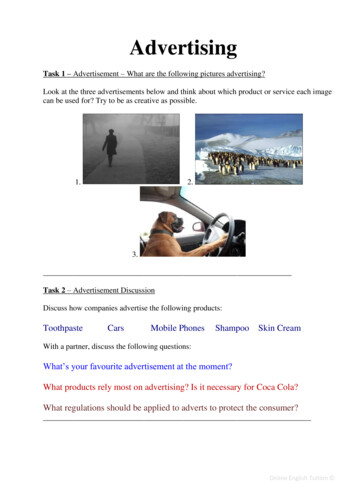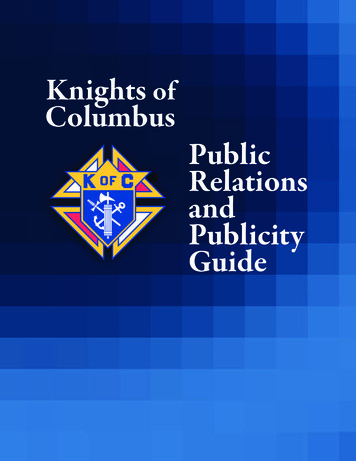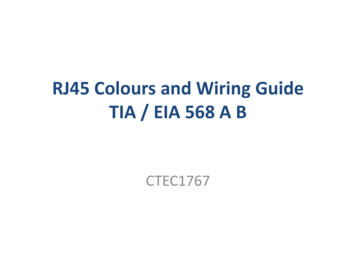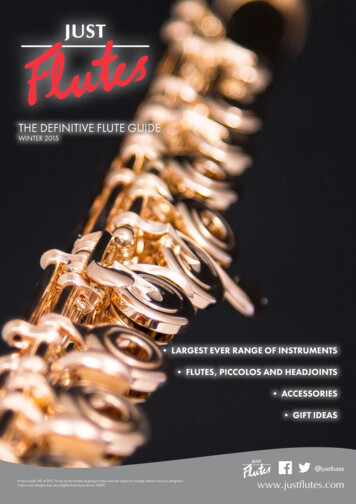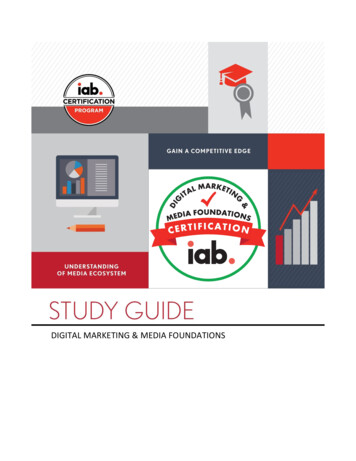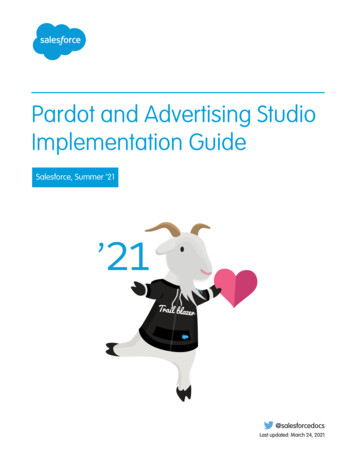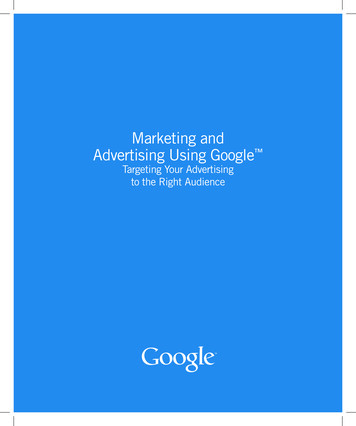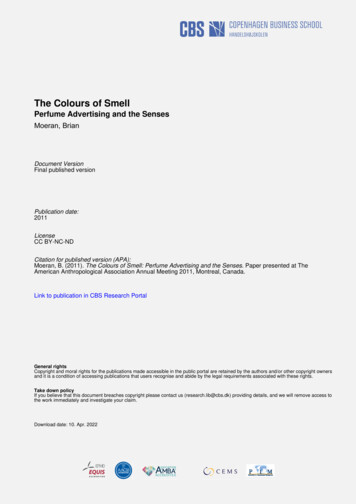
Transcription
The Colours of SmellPerfume Advertising and the SensesMoeran, BrianDocument VersionFinal published versionPublication date:2011LicenseCC BY-NC-NDCitation for published version (APA):Moeran, B. (2011). The Colours of Smell: Perfume Advertising and the Senses. Paper presented at TheAmerican Anthropological Association Annual Meeting 2011, Montreal, Canada.Link to publication in CBS Research PortalGeneral rightsCopyright and moral rights for the publications made accessible in the public portal are retained by the authors and/or other copyright ownersand it is a condition of accessing publications that users recognise and abide by the legal requirements associated with these rights.Take down policyIf you believe that this document breaches copyright please contact us (research.lib@cbs.dk) providing details, and we will remove access tothe work immediately and investigate your claim.Download date: 10. Apr. 2022
The Colours of Smell:Perfume Advertising and the SensesBrian MoeranAbstractThis paper examines perfume advertising within the overall context of theoreticalapproaches to the study of smell. Pointing out that smell is marked by a paucity oflanguage, it proceeds to examine how smell is represented in perfumeadvertisements. Based on an analysis of more than 250 ads worldwide, the paperasks if there are any consistent relations between language, colours and smellmaterials, as well as between models’ poses, seasons, and classes of perfume (floral,oriental, woody, and so on). It proceeds to survey a number of writings linkingcolour with smell, and suggests that olfactory marketing should, perhaps, be moreconsistent in its linking of these two domains in advertising and packaging.KeywordsAdvertising, classification, colour, language, olfactory marketing, perfume, smellAuthorBrian Moeran is Professor of Business Anthropology and Director of the reativeEncounters research programme at the Copenhagen Business School. Among hispublications on advertising are A Japanese Advertising Agency (Curzon, 1996) andEthnography at Work (Berg, 2006). He has also edited, with Timothy de Waal Malefytof BBDO New York, a volume, Advertising Cultures (Berg, 2003), and a four volumeseries, Advertising: Critical Readings (Berg, 2010).1
The Colours of Smell:Perfume Advertising and the SensesBrian Moeran‘We live in a world of smells, where only the absence of smell is remarkable.’(Moncrieff 1970: 17)Smell ‘Myths’This paper is about the language and representation of smell. With aparticular focus on perfume advertisements, it describes, on the one hand,how smell is classified and talked about and, on the other, how colour hasbeen used to represent smell. Its aim is to put forward a number of theoreticalquestions which, in the opinion of the author, need further research. AsDanièle Dubois (2006: 90) notes, compared with that of colours, the scientificexploration of odours remains problematic.The theoretical discourse devoted to smell ‘reflects a maze of fascinatingtaboos and mysterious attractions’ (Corbin 1994: 8). Almost everyone writingabout smell makes use of a set of ‘myths’ – a particular ‘mode of signification’or ‘form’ (Barthes 1957: 193) – in his or her presentation of olfactory facts.Such myths include health, morality, otherness, physiology, seduction,sexuality, social bonding, even the number of smells (Avery 2008: 1-5), amongother themes, and cover a broad range of cultural, historical, linguistic, moral,(neuro-)physiological, racial, religious, sexual, social and symbolic olfactoryphenomena.Although this is not the place to enter into a detailed description of allaspects of this academic mode of signification, three of these myths arerelevant to the following discussion and analysis of perfume advertisingaround the world. The first is the myth of the undervalued sense. Because ‘theolfactory experience is difficult to define’ (Rouby et al. 2002: 1), smell becomesthe ‘suppressed’ or ‘forgotten’ sense (Wyatt 1993: 270; Watson 2000: 3), and so‘remains the great uncharted frontier of sensory science’ (Gilbert 1995: vii; cf.Ellis 1928: 51-52). The evidence from perfume advertising supports this myth,in the sense that hardly any perfume advertisements refer to properties ofsmell as such when promoting particular products or brands. In all the 264advertisements analysed, only one (for Juicy Couture) makes a direct reference2
to the fact that a perfume is olfactory: with the headline ‘Smell me!’ Fewerthan half a dozen others hint directly at their olfactory ingredients. Exceptionsinclude ‘an intense harmony of rare and precious woods’ (Cacharel’s Noa Eaude Parfum); ‘provocatively spicy and ‘le nouveau fleuri boisé’ (Kenzo JungleElephant and Tigre respectively).Second is the myth of articulation.1 Smell is characterized by a ‘bafflingpoverty’ of nomenclature to describe it (Locke 1841: 65; Engen 1987; cf.Theophrastus 1926 [371-287 B.C.E.]: 327), other than in terms of its causes (thesmell of roses, for example) or its effects (an enchanting smell) (Sperber 1975:115-119). In a vast majority of languages, smell has no primary olfactorywords (Williams 1976), no independent taxonomy, and does not lend itself tomental abstraction. This makes smell seem the ‘least intellectual’ of the senses(Gonzalez-Crussi 1989:65).2 As we shall see, this myth explains the adoptionof certain marketing practices, such as product naming and the choice ofcolours used in packaging.Perfume advertisements resort to two immediate strategies to overcomethe problem of olfactory perception. Either they make, albeit limited, use ofother senses (such as ‘It touches everything’ [Calvin Klein Beauty] orMonsoon’s ‘see more, hear more, smell more, taste more, feel more’). Or theyrefer to the senses in general (‘a fragrance to seduce the senses’ [DonnaKaren’s Cashmere Mist]). At the same time, however, they frequentlytransform the senses into sensuality (witness ‘sensuality to the extreme’ [YvesSaint Laurent Opium] and ‘unveil your sensuality’ [Lancôme Hypnôse Senses]).Third, there is the myth of transformative ritual practices. Incense has beenused in Assyrian, Babylonian, Buddhist, Chinese, Egyptian, Greek, Hebrew,Hindu, Japanese, Maya, Minoan Cretan, Parthian, Phoenician, Roman, even –eventually – in Christian rites of worship. ‘The spreading of the smoke andfragrance of incense and the visible movement of that smoke upwardstowards the heavens has given it a symbolical relationship to prayer, makingthe offering synonymous with worship’ (Groom 1981: 2).3 Not surprisingly,the word, perfume – it is frequently noted (e.g. Rimmel 1865: 4; Ackerman1990: 56; Stoddart 1992: 168; Goody 1993: 33; Pybus and Sell 1999: 3; ; Classenet al. 1994: 16) – means ‘through smoke’ (from the Latin per fumum). Perfumethus ‘included the notion of communicating, even conveying prayers, withthe gods above’ (Goody 1993: 3) as fragrant resins were burned to create aIt has been claimed that the only inborn olfactory mechanisms is an aversion to putrefactionand dead bodies (Köster 2002: 32). This does not explain how new-born babies smell theirway to their mothers’ breasts.1As a result, philosophers from Plato onwards have regarded smell as a ‘primitive’ or ‘lower’sense (Aristotle 1936: 103-127; Le Guérer 2002: 4), inferior to the ‘most intellectual’ or ‘higher’sense of sight (Ellis 1928: 82; McCartney 1968: 1; Corbin 1994: 6-7).2Is it any surprise, then, that the assembly of cardinals, gathered to elect a new Pope, shouldsignal agreement on their choice by lighting a fire and sending out smoke through a chimneyin the Vatican for all outside to see? The Pope, like the kings of ancient Assyria, is anintermediary between people and gods, separated from each by ‘holy fire’.33
physical pathway between heaven and earth (Classen et al. 1994: 42; Dove2008: 21).Incense has been, and still is, burned to ‘ward off enemies of the dead’(Groom 1981: 3), as well as to commemorate the dead (cf. Rimmel 1865: 139166). The Egyptians held that ‘the gods exuded a sweet odour and that safepassage to an after-life could be assured if the cadaver was provided withsufficient fragrance’ (Stoddart 1992: 169; Groom 1981: 3). They called incensethe ‘divine odour’; it was the very sweat of the gods that had fallen to earth(Stamelman 2006: 113). Similarly, the words of Buddha were said to befragrant, while the smell of incense was thought to invoke the Buddha’spresence (Morita 1992: 34).4The transformatory nature of incense and perfume is clearly apparent infragrance advertising: ‘Just one moment can change everything’ (CalvinKlein’s Eternity Moment); ‘Ce que vous êtes, ce que vous deviendrez’ (Natori); and‘Une femme ne porte pas mon parfum Elle devient Chloé’ (Chloe). Moreover, aperfume can even mark a social transition: ‘Born to reveal the woman you’vebecome. Not just a perfume. A rite of passage’ (Valentino) – therebysupporting anthropological literature which suggests that in almost allsocieties there is a connection between olfaction and transition (Gell 1977: 28),and that this connection can be explained at logical, psychological andsociological levels (Howes 1987). Olfaction is used on various ritual occasionsto mark a category change (for example, from profane to sacred and vice versa,from life to death, and so on). Smells are therefore closely associated withliminal occasions (such as birth and death), because they are ‘matter out ofplace’ (Douglas 1975: 50) formless, resisting all attempts at description andclassification, and crossing boundaries, ‘neither here nor there betwixt andbetween’ (Turner 1969: 81). Their very continuity enables us to link socialcategories to one another (Howes 1987: 408).Smelling the DifferenceThis research began from a simple observation. It is known that differentmembers of different peoples living in different parts of the world tend toexhibit smell preferences that are peculiar to them, even though there are nodifferences in biological makeup among such peoples. Such preferences maydepend on age, gender (Moncrieff 1966), and social class (Classen 1992: 136-8),but are also often formed in particular social, cultural and physicalenvironments. Cattle herding pastoralists in the Sudan and East Africa, forexample, anoint or smear themselves with the body products – urine anddung, in the main – of their cows (Evans Pritchard 1940: 37), while their ghee isconsidered to be both an assurance of fertility and the ‘perfume’ of womenThis ‘odour of sanctity’ (Ellis 1928: 55, 62) came in another form: if a sweet smell issued forthfrom a corpse when a tomb was opened, it was held to be proof of sainthood in the MiddleAges (Gonzalez-Crussi 1989: 74-76; Goody 1993: 182; Classen et al. 1994: 52-54; Corbin 1994:244-245 [with quotes going back to 1901]).44
(Almagor 1987: 109). The Papuans of Kaiser Wilhelm’s Land used to rubfragrant plants into their bodies in order to induce love in their partners (Ellis1928: 95). For the African Bushmen the loveliest smell is that of rain (Fox 199*:31). Citronella scents in laundry products are better accepted in Europe,where citronella means ‘old-fashioned cleanliness’, than in the United States,where the most common use of citronella oil is in insect-repellent candles(Jellinek 1975: 199).Often differences in smell preferences are connected with food(Moncrieff 1966: 209, Classen 1992: 135). The Dogon of Mali, for instance, liketo rub fried onions all over their bodies, since the scent of onion is by far themost attractive fragrance a young man or woman can wear (Fox 199*: 30). TheJapanese have customarily referred to Europeans and Americans as ‘stinkingof butter’ (batakusai) (and have themselves been said to smell of soy sauce andpomade [Kirkup 1985]), and north Europeans have tended to regard thoseliving in the Mediterranean region as ‘reeking of garlic’. Although in southernAsia and many African countries, women have traditionally used vegetableoils in their hair to beautify themselves, the smell of rancid oils is rejected asreminiscent of spoiled food in countries where this cosmetic practice is notprevalent (Jellinek 1975: 198-9).In spite of such obvious differences in cultural preferences and resulting‘smellscapes’ (Porteous 1985), and in spite of the fact that a casual stroll alongthe main thoroughfares of any large city around the world quickly gives animpression of the kinds of perfume that the women living there like to wear,perfume advertisements suggest that there exists but a single set of smellpreferences in the world today. Regardless of whether they appear onhoardings or in magazines published in Hong Kong or the USA, in France orJapan, in Russia, South Africa, or Brazil, advertisements for such brands asChanel’s No 5, Christian Dior’s Addict, and Guerlain’s Mitsouko all make useof the same visual images and the same headlines and copy to appeal to theirdifferent target audiences. In the world of perfume advertising, gender andage differences may be addressed – witness the general distinction betweenmasculine and feminine perfumes, on the one hand, and the advertising ofShalimar to ‘mature’ women and Jennifer Lopez’ Still to teenagers and womenin their early 20s, on the other – but smell preferences are assumed to beuniversal, rather than culturally distinct.Clearly, there is sound economic reasoning behind such an approach.Perfume manufacturers wish to sell a product that has global, rather thanmerely local, appeal. They are not prepared, therefore, to alter the formulaused to make Lancôme’s Trésor or Calvin Klein’s Eternity merely to make eachperfume more appealing to particular peoples living in particular parts of theworld with their particular climates, local foods, environmental conditions,and smell preferences. It makes no business sense to manufacture and marketObsession scented with cow’s urine in the Sudan, or Midnight Poison withMarmite in the UK.5
All the same, the challenge for the perfume industry has been twofold:first, how best to overcome particular cultural olfactory preferences; andsecond, how best to represent smell in visual form. It could be argued that theindustry’s answer to the first part of this challenge has been simply to ignorethe fact that different peoples in different parts of the world tend to exhibitdifferent olfactory preferences. In a way, this is exactly what it has done. Butsuch apparent olfactory imperialism is rooted in the major communicativeproblem mentioned above: our sense of smell cannot adequately be describedin words and so transformed into a readily recognizable form of linguisticcommunication.This cognitive failing makes the second part of the perfume industry’schallenge even more urgent: how to establish a system of representation thatwill evoke a particular fragrance and ensure that each perfume somehowovercomes gender, age and cultural preferences so that it is accepted –admittedly to a greater or lesser degree, but accepted all the same – byconsumers all over in the world. This is the rationale underlying theintroduction of families (fresh, floral, woody and oriental) by which perfumesare currently classified – something to which I will return later on in thisessay.Perfume AdvertisingAlthough academic analyses of advertisements can be criticised for revealingmore about analyst’ preoccupations than about advertisers’ intentions, it isclear that advertising professionals do understand and make use of signifiers,signifieds, and signs in the construction of advertising campaigns. In otherwords, they do try to transfer more or less structured characteristics andvalues prevalent in the socio-cultural domain to products, services andbrands (Williamson 1978: 43). The issue is not if they do it, but why, how, andfor whom they do so (Moeran 1996).The manufacture of perfumes and fragrances is an essential componentof the fashion industry. It is the point of entry for women wishing to buyfashion clothing.5 Perfume advertising, like fashion and many other‘experience’ products, appeals to images and emotions, rather than toinformational elements. In other words, it does not describe a perfume’s scentThere is a sense in which perfume echoes fashion, of which it is an intricate part. Just asfashion ‘rests on a violent sensation of time’, destroying that which it has just been admiringand is about to destroy (Barthes 2006: 106), so is perfume subject to its ephemeral character.Heart notes take over from top notes, and base notes from heart, as each set of olfactorymolecules evaporates in the air. The sensation of time in perfume is not violent, but it isinexorable in its presence, waning away and loss. Is there, though, a style (a sense of chic) inperfumes, as Barthes argues for Chanel. Do perfumes such as Mitsouko, Jikky, Miss Dior andChanel No 5 constitute a style of continuity that is set against the come-and-go fashionperfumes of Champagne, Champs Elysées and celebrity names? How many perfumes are ‘relaunched’ in an effort to achieve fashionable success that lasts little longer than a singlefashion season of spring/summer or autumn/winter?56
and only rarely hints at the materials that go into its making (Goldman 1992:23). A perfume ad does not focus on product attributes (in the way that an adfor a laundry soap powder might do), but accentuates user image. It sells amood or fantasy rather than a fragrance per se (Goldman 1992: 26). By invitinga woman to look sexy or fresh, to feel intoxicated or natural, perfumeadvertising in general ends up accentuating a look or feeling, rather thansmell (the undervalued sense, once more). Odours used in perfumes do not inthemselves denote anything in the publicity material advertising them. Rather,they are used metaphorically as symbols that connote a woman’s inner self,sensuality, beauty, desire, and, among other themes, the possibility oftransformation. So ‘smell is sundered from its natural context’ (Goldman1992: 27) as advertisers make use of semiotic (visual) and semantic (verbal)information ‘to precipitate odour identification towards specific arbitrarymeanings (mostly coinciding with the perfumer’s ones) to prompt perfumepurchases’ (Velasco-Sacristán and Fuertes-Olivera 2006: 219).Unable to describe or invoke the particular fragrance of its product,perfume ads almost invariably make use of both cause (a floral note, anoriental accord) and effect (an exhilarating, magical or intoxicating scent), whichare then represented and reinforced by means of images, colours andlanguage (such as a serpent wrapped around the neck of a naked woman withbrightly painted red lips, emphasizing sin, desire, or other advertisedolfactory effect).The naming of smells ends up as the naming of the sources of smells(Sperber 1975: 115), so that in a perfume a number of different sources may beselected as representative of that fragrance. Thus does an ‘oriental with afloral heart’ perfume like Dior Addict, for example, advertise its top note asSicilian mandarin, heart note as Queen of the Night (tuberose to you or me),and base note as vanilla. It is further advertised as having a ‘fresh and fruityaccent’, as well as ‘sweet and spicy accords’.6 The problem with this kind ofolfactory categorization is that when odour components are successfullybalanced, they tend to lose their perceptual individuality and fade away inthe face of the fragrance as a whole. This is known as ‘olfactory form,’ which like a Durkheimian collective or Gestalt theory ‘yields more than the sum ofits components’ (Holley 2002: 19). As a result, individual ingredients becomemeaningless, while the overall classification of Dior Addict as an ‘oriental witha floral heart’ merely tells potential purchasers that the perfume claims tohave some heavy base note ingredients with one or more flowers as middlenotes.In addition, website publicity also points to a fragrance’s symboliceffects. Here, image marketing is brought to bear to produce an ‘olfactoryaura’ that gives perfumes a ‘pseudo-magical force’ (Classens, Howes andA perfumer relies both on purely sensory expertise and semantic knowledge whencomposing a perfume. During this process s/he is able to create a mental image of a perfumeand imagine the odours of which it is composed (Holley 2002: 24).67
Synnott 1994: 188). This is borne out by phrases like ‘timeless, magical andfeminine’ for Givenchy’s Organza, which ‘rouses the goddess hiding in everywoman’; or an ‘oriental harmony’ described as ‘very warm, sensual, almostbewitching’.7 When in full-flight, website publicity (like this particular brand)becomes addictive: Dior Addict is the ‘soul of enchantment’, an ‘intenselyseductive, serene, sensual scent’ for the ‘sophisticated, passionate, intuitivewoman who ignores dictates and follows her own rules’. Although Jellinek(1990: 17) understandably argues that the perfume industry should changethe way it communicates its products and ‘describe perfumes in words andterms that the end consumer finds meaningful’, it is hard to see how thismight be successfully achieved. Because of the paucity of olfactory terms,smell more or less has to be represented as something else. Metaphors have tobe used.But how? Odours (sandalwood, bergamot, oakmoss) rarely indicateanything in themselves (lavender, lemon, mint, orange, and rose are amongthe exceptions). They have to be accompanied by visual and/or linguisticsigns (romance, freshness) for them to ‘make sense’. How do advertisers goabout constructing such signs?‘The most meaningful signifiers of female fragrance advertising are adheroine and colour scheme/background. Static or dynamic image, pose,smiling or serious expression, clothes, make-up; as well as dark or light,bright or neutral, and complicated or simple colour scheme, creates theemotional overtone and sense of the advertising. Product appearance andverbal text are secondary elements’(Papanthymou 2003: 3)The three most important elements in the composition of perfume ads, then,are visual images, colours, and language. It is on these that this research hasfocused as it sought to ascertain if perfume advertising constitutes a visualsystem. Some of the questions posed of the material have been:1. Is there any consistent relation between the different visual elementsof a perfume advertisement (headlines, model’s dress and/oraccessories, perfume bottle, and so on) in terms of matching ofcolours and/or overall tone and/or forms? Answer: yes, fairly consistent matching of colour among visualelements in individual advertisements, and occasional matchingof form (for example, between model’s pose and bottle shape).2. Is there any consistent relation between a model’s appearance (haircolour, state of un/dress, and so on) and the language (keywords)used to represent a perfume? 7Answer: no, except that there seems to be a tendency for thetheme of sexuality and/or seduction to be accompanied visuallyby a state of undress or .html. Consulted 19 September, 2000.8
3. Is there any consistent relation between the model’s hair colour andthe fragrance family of perfume advertised (floral, fresh, oriental andwoody)? Answer: some, to the extent that black haired models tend not tobe used to advertise floral perfumes, while blondes are muchmore common in ads for fresh perfumes than they are for otherfragrance families. (See Table 1)4. Is there any consistent relation between a model’s appearance andolfactory ingredients? Answer: no.5. Is there any consistent relation between the fragrance family ofperfume advertised and the overall visual tone used in anadvertisement? In other words, can we expect to find lighter tonesused in ads for – say – fresh and floral, and darker in oriental,perfumes? Answer: For the most part, no. But oriental perfume ads tendtowards an overall (medium) dark tone, as do woody perfumeads to a lesser extent. Fresh and floral perfume ads do not exhibita tendency towards lighter tones. (See Table 2)6. Is there any consistent relation between the fragrance family ofperfume advertised and the colours used in an advertisement? Inother words, can we expect to find consistent use of green and brownwith woody perfumes, for example, or white, red and yellow withfloral perfumes? Answer: generally speaking, no. But advertisements for floralperfumes use comparatively more pink and blue, as well as greyscale, than do those in other categories. Ads for oriental perfumesuse comparatively more skin, black and purple, very little white,and no blue. Although the sample for this category is small, adsfor fresh perfumes use no black or red, and comparatively moregreen and yellow. (See Table 3)7. Is there any consistent relation between the use of language(keywords) and the use of colours, such that one might predict thatthe theme of nature, for example, will normally be represented byyellow and green, or romance by red or pink? Answer: generally speaking, no. But skin advertisements (that is,those in which the predominant or only colour is the model’s bareskin) predominate in the categories of beauty, fantasy, fresh ness,luxury, nature, sensuality, time, transformation and un/dress.There are also no grey-scale ads in the freshness category. (SeeTable 4)9
8. Is there any consistent relation between the use of language(keywords) and fragrance families, such that one might predict, forexample, that floral perfumes might be associated with femininity,and oriental with seduction? Answer: for the most part no. When present, often marked by theabsence of a particular linguistic category. Thus, ads for freshperfumes do not make any use of keywords hinting at seduction,while ads for floral perfumes never make use of fantasy. On thepositive side, floral perfumes are advertised by keywordssymbolizing beauty, nature and luxury (none of which are foundin advertisements for fresh, and hardly at all for oriental,perfumes). (See Table 5)9. Is there any consistent relation between the use of language andolfactory ingredients, such that one might predict, for example, thatthe inclusion of (a synthetic) ambergris will normally beaccompanied by keywords denoting sultriness, or of rose bykeywords denoting romantic love? Answer: not yet analysed. (Table 6 to be created)10. Is there any consistent relation between olfactory ingredients and theuse of colours, such that one might predict that the inclusion ofjasmine, for example, will normally lead to the dominance of white(or yellow), and of orange to the colour of the same name? Answer: no. (See Tables 7a, 7b, and 7c)11. Is there any consistent relation between the use of overall colourtones and the season in which a perfume is advertised? Answer: no, except that medium dark and dark werecomparatively more frequent in ads appearing during the autumnand winter months of the year. (See Table 8)12. Is there any consistent relation between the use of individual coloursand the season in which a perfume is advertised? Answer: no, except that white is used comparatively less inautumn and winter than in the other seasons of the year. (SeeTable 9)These questions and answers were derived from about twenty years ofsporadic gathering of perfume advertisements during the course of previousresearch on advertising, as well as on women’s fashion magazines publishedin five different countries (France, Hong Kong, Japan, the UK, and USA)between 1985 and 2005 (Moeran 1996, 2005). These I then divided intofeminine and masculine groups, and set aside the latter. Next, together withtwo research assistants,8 we entered those advertisements for feminine8 I am very grateful to Frederik Larsen and Sarah Netter for their extended work on thisproject research .10
perfumes featuring both a female model (sometimes accompanied by a malemodel) and some form of descriptive language (264 ads in all) into a database,where such features as keywords, overall tone, dominant colours, model’sdress colour, perfume bottle colour, and other relevant visual and linguisticelements were highlighted. From these we tried to synthesize linguisticcategories and colours. Each perfume entered in the database also carriedinformation on its olfactory properties: namely, overall family in which it wasclassed (fresh, floral, woody and oriental); together with the main ingredientsmaking up its top notes (e.g. bergamot and orange blossom), middle notes(e.g. rose and jasmine), and base notes (e.g. oakmoss and vanilla).Advertisements featuring only a bottle (with or without language), or a modelbut no language (other than ‘The new fragrance from ’ or ‘The new femininefragrance’), were put aside for future research.The apparent simplicity of the questions posed above raised problemsregarding both the methodology and analysis that followed. In the first place,we had to fix on one of several dozen methods used to distinguish andmeasure colours. Should we employ the Natural Color System used bySchifferstein and Tanudjaja (2004), for example? Or the Munsell Book of Coloremployed by Gilbert, Martin and Kemp (1996)? Or one of the many colourwheels available on the Internet? How were we to take into account the factthat different advertisements for the same perfume can differ in hue (so that,for example, yellow becomes more like gold, or vice versa), as a result ofprinting conditions?In the end, we opted for a simple primary- and secondary-colour schemeof red, purple, blue, green, yellow, and orange, to which we added black,white and grey. We then conducted independent matching of up to threedominant colours found in individual ads. On the basis of this, we agreed tofurther add grey-scale, pink and gold because of their frequent usage and apossible assumed link between pink and love, on the one hand, and gold andluxury, on the other.Secondly, how were we to deal with olfactory ingredients? Should weadopt one of the classical systems of olfactory classification: the CrockerHenderson odour classification set, for example, with its four fundamentalodour asso
Perfume Advertising and the Senses Brian Moeran Abstract This paper examines perfume advertising within the overall context of theoretical approaches to the study of smell. Pointing out that smell is marked by a paucity of language, it proceeds to examine how smell i

